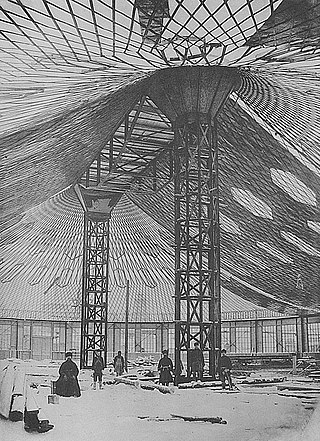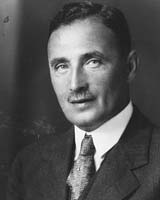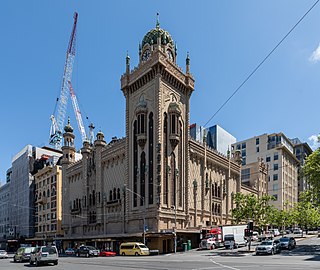
Judith Durham was an Australian singer, songwriter and musician who became the lead singer of the Australian folk music group the Seekers in 1962.

Arts Centre Melbourne, originally known as the Victorian Arts Centre and briefly called the Arts Centre, is a performing arts centre consisting of a complex of theatres and concert halls in the Melbourne Arts Precinct, located in the central Melbourne suburb of Southbank in Victoria, Australia.
The Melbourne Convention and Exhibition Centre (MCEC), colloquially referred to as Jeff's Shed, is a group of three adjacent buildings next to the Yarra River in South Wharf, an inner-city suburb of Melbourne, Victoria, Australia. The venues are owned and operated by the Melbourne Convention and Exhibition Trust.

In structural engineering, a tensile structure is a construction of elements carrying only tension and no compression or bending. The term tensile should not be confused with tensegrity, which is a structural form with both tension and compression elements. Tensile structures are the most common type of thin-shell structures.

Sidney Myer was a Belarusian-born Jewish-Australian businessman and philanthropist, best known for founding Myer, Australia's largest chain of department stores.

Kings Domain is an area of parklands in Melbourne, Victoria, Australia. It surrounds Government House Reserve, the home of the governors of Victoria, the Sidney Myer Music Bowl, and the Shrine Reserve incorporating the Shrine of Remembrance.
Victorian Opera is an opera company based in Melbourne, Victoria, Australia. The company was founded in 2005 by the Victorian Government as a replacement for the Victoria State Opera. It commenced operations in January 2006 with Richard Gill as Artistic Director. Richard Mills is the current Artistic Director. The company is supported through government funding, patron contributions and corporate sponsorship.

The Forum Theatre is a historic theatre and former cinema now used as a live music and event venue located on the corner of Flinders Street and Russell Street in Melbourne, Australia.
Barry Beauchamp Patten was an Australian Olympic alpine skier and architect who designed Melbourne's Sidney Myer Music Bowl.
The Zelman Memorial Symphony Orchestra is the longest-running community orchestra in Melbourne, Australia.

Melbourne Recital Centre (MRC) is a venue and organisation for live music in Melbourne, Victoria, Australia. The organisation programs and presents more than 500 concerts and events a year across diverse range of musical genres including classical and chamber music, contemporary, pop, folk, rock, electronica, indie, jazz, cabaret and world music. Opened in 2009, the centre is Melbourne's second largest auditorium for classical music.

Future Entertainment is a Melbourne based, youth-focused electronic music entertainment company created by dance-music event organiser Mark James in 1993. Its objective was to present annual music festivals at Australian venues and landmarks.
The Astra Chamber Music Society is a concert organisation for choral music and contemporary performance, based in Melbourne, Australia and under the musical direction of John McCaughey.
Margaret Josephine Nisbett MBE was an Australian coloratura soprano.
The Melbourne Arts Precinct is home to a series of galleries, performing arts venues and spaces located in the Southbank district of Melbourne, Victoria, Australia. It includes such publicly-funded venues as Arts Centre Melbourne, National Gallery of Victoria and Southbank Theatre, along with various offices and training institutions of arts organisations.

Hamer Hall is a 2,466 seat concert hall, the largest indoor venue at Arts Centre Melbourne, used for orchestra and contemporary music performances. It was designed by Roy Grounds as part of the Cultural Centre that comprised the National Gallery of Victoria and the Arts Centre Melbourne. It was opened as the "Melbourne Concert Hall" in 1982 and was renamed Hamer Hall in honour of Rupert Hamer shortly after his death in 2004.

Kenneth Baillieu Myer, was an American-born Australian patron of the arts, humanities and sciences; diplomat, administrator, businessman and philanthropist. He was a member of the notable Melbourne retailing Myer family. Myer made significant philanthropic and personal contributions to the development of major national institutions, most notably the Howard Florey Laboratories of Experimental Physiology and Medicine, the School of Oriental Studies at the University of Melbourne, the Victorian Arts Centre and the National Library of Australia. In 1959, he became Benefactor and Co-Founder of The Myer Foundation with his brother Baillieu Myer AC. He was also the founding chairman of the Australian Broadcasting Corporation.
Yuncken Freeman was an Australian architecture firm. Founded in Melbourne, Victoria in 1933, Yuncken Freeman grew steadily, particularly in the post-war economic boom to be a sizeable firm in Australia, with branch offices in Hong Kong as well as other parts of south-east Asia, until its dissolution during the late 1980s.

Emporium Melbourne is a luxury shopping centre on the corner of Lonsdale and Swanston streets in Melbourne, Australia. Occupying the former Lonsdale Street site of Myer's Melbourne store, Emporium opened in 2014 following extensive redevelopment. The centre includes a food court, specialty stores and several multi-level anchor retailers, as well as a top floor extension of Myer's Bourke Street store. Emporium forms part of a 188,000 square metres (2,020,000 sq ft) precinct of linked shopping centres in the Melbourne central business district, which also includes the Myer and David Jones city stores, Melbourne Central, General Post Office and Elizabeth Street's The Strand.

The Maggie Edmond Enduring Architecture Award is an architecture prize presented annually since 2003 at the Victorian Architecture Awards by the Victorian Chapter of the Australian Institute of Architects (AIA). The award is presented to recognise long lasting, authentic and enduring architecture with usually more than 25 years since the completion of construction.















